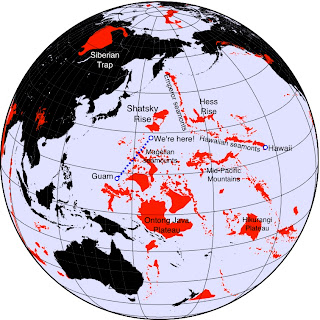
Well, the cruise MGL1206 finally ended. We arrived in Honolulu this morning, a day earlier than originally planned. The weather got so much better once we left the survey area, and we were able to sail at 12 knots for most of the transit. Thanks to the hard work of the ship crew, science techs, and watch standers, our scientific mission was accomplished in full. I'd like to emphasize I'm always very much impressed by the professionalism of the Langseth crew and science techs. The fact that they are great may not be surprising, because, to survive in the middle of the oceans, you should be able to not only expect the unexpected but also solve it quickly with what's available on a ship. Still, seeing those talented people gathered in one place and spending a few weeks with them is a real privilege for someone like me.
I sometime wondered what the role of a chief scientist would be. I certainly had to make a scientifically important decision, e.g., whether we should turn back to fill a gap in data or keep shooting, but that happened only twice. Planned data acquisition was streamlined so nicely by the science techs, and I just had to keep myself out of their ways. Watch standers were all great and hard-working, and they rarely needed my instruction. One thing I did for sure is keep being worried. A cruise like this can give you more than enough to worry, such as instrument failure, bad weather, strong currents, sickness, injury, and encounters with marine mammals. Actually, all of those bad things happened during the cruise, but fortunately none of them was too grave to prevent us finishing our plan (phew).
To me, this is not the end of a 23-day cruise. In my mind, the whole thing started in July 2010, so I guess I've been under certain tension for nearly two years. Now with everything we wanted in our hands, we can finally decipher the mystery of Shatsky Rise. We'll be busy for at least another year!
I'd like to thank everyone for everything. I hope someday I'll come back to this wonderful ship and work with these special kind of people again, with a new exciting idea to explore.
























 By the way, when I got to my stateroom, I had a nice surprise from the previous chief scientist. There was a note on the desk with two bags of coffee beans, which reads "Jun, hope you have a productive and successful cruise! - Nathan Miller (chief sci. on MGL1205)." What a nice thing to do! Thank you so much, Nathan.
By the way, when I got to my stateroom, I had a nice surprise from the previous chief scientist. There was a note on the desk with two bags of coffee beans, which reads "Jun, hope you have a productive and successful cruise! - Nathan Miller (chief sci. on MGL1205)." What a nice thing to do! Thank you so much, Nathan.
